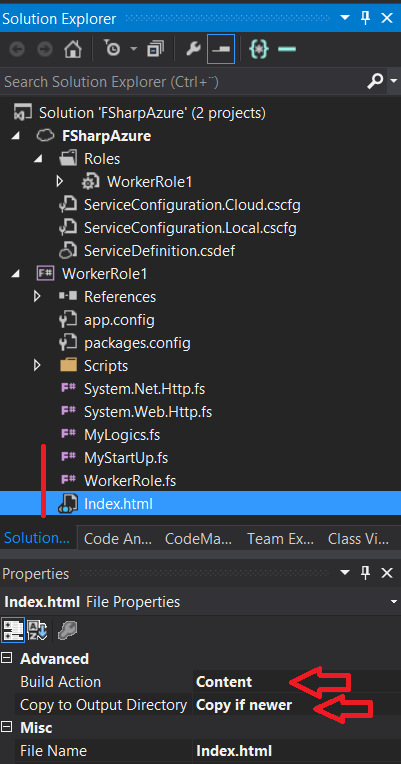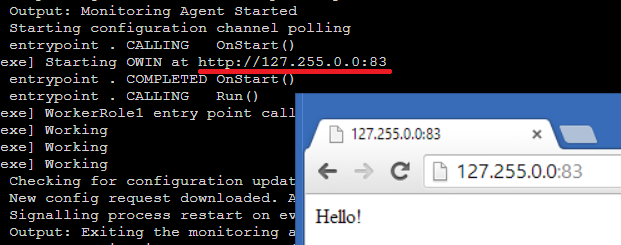OWIN-interface and SignalR-messaging
OWIN is an interface, which allows you easily to register components, like:
- WWW-file-server
- REST-Web-interface
- SignalR-communication
- Authentication
- Etc. (in the future, even IIS)
OWIN and SignalR need some infrastructure ceremony to run... Let's use the WorkerRole-project and file server component Microsoft.Owin.StaticFiles.
Technology Choice
This practice uses SignalR, which achieves two-way communication. Another typical way would be CRUD-style REST API, which is demonstrated in an OWIN-F#-code example.
This practice uses WorkerRole and OWIN. Another quite applicable solution would be creating an (C#/VB.NET) ASPNET Web Role, where you can reference F#-library-project. Then you would get some of the IIS-infrastructure on top of that, but may run to some possible background-threading-problems.
Adding a Start-up-block
Select the WorkerRole-project, right mouse click over that, and select Add -> New Item... -> Source File, and add a file MyStartUp.fs to the project, with content:
1: 2: 3: 4: 5: 6: 7: 8: 9: 10: 11: 12: 13: 14: 15: 16: 17: 18: 19: 20: 21: 22: 23: 24: 25: |
module MyStartUp open Owin open Microsoft.AspNet.SignalR let hubConfig = HubConfiguration(EnableDetailedErrors = true, EnableJavaScriptProxies = true) type MyWebStartup() = member x.Configuration(app:Owin.IAppBuilder) = //OWIN Component registrations here... //SignalR: app.MapSignalR(hubConfig) |> ignore //Static files server (Note: default FileSystem is current directory!) let fileServerOptions = Microsoft.Owin.StaticFiles.FileServerOptions() fileServerOptions.DefaultFilesOptions.DefaultFileNames.Add("index.html") //fileServerOptions.FileSystem <- Microsoft.Owin.FileSystems.PhysicalFileSystem(@"c:\wwwroot\") app.UseFileServer fileServerOptions |> ignore () [<assembly: Microsoft.Owin.OwinStartup(typeof<MyWebStartup>)>] do() |
Move this file in Solution Explorer to the top of WorkerRole.fs, so it will be executed before WorkerRole-file.
Index.html
The code above defines the index.html to be the default start-up-file of the WWW-server. The default path is the project output-path. So, add to project a TextFile called index.html. From the properties of the index.html modify the "Build Action" to value "Content" and the "Copy to Output Folder" to value "Copy if newer".

Index.html will contain some kind of content and a pile of JavaScript: SignalR-JavaSctipt-client-side components. But to start with, just write there some kind of test-greeting.
Configuration and the Start-Up
Deployment-project has ServerDefinition.csdef-file, which contains server settings. At first you may change the WorkerRole-tag attribute vmsize-setting from "Small" to "ExtraSmall". Inside WorkerRole-tag is Imports. The side of Imports, copy a new tag called Endpoints. The file should look something like this (of course, depending on your project's name, etc.):
<?xml version="1.0" encoding="utf-8"?>
<ServiceDefinition name="FSharpAzure"
xmlns="http://schemas.microsoft.com/ServiceHosting/2008/10/ServiceDefinition"
schemaVersion="2013-10.2.2">
<WorkerRole name="WorkerRole1" vmsize="ExtraSmall">
<Imports>
<Import moduleName="Diagnostics" />
</Imports>
<Endpoints>
<InputEndpoint name="Endpoint1" protocol="http" port="80" localPort="80" />
</Endpoints>
</WorkerRole>
</ServiceDefinition>
Next, open WorkerRole.fs file. Add inside the class, before methods, this webApp-variable, which is used to free-up resources, and also override for OnStop-method:
1: 2: 3: 4: 5: 6: |
let mutable webApp = Unchecked.defaultof<IDisposable> override wr.OnStop() = if webApp <> Unchecked.defaultof<IDisposable> then webApp.Dispose() base.OnStop() |
Then open wr.OnStart() method and copy before the call base.OnStart() this small source code:
1: 2: 3: 4: 5: 6: |
let endpoint = RoleEnvironment.CurrentRoleInstance.InstanceEndpoints.["Endpoint1"] let baseUri = sprintf "%s://%A" endpoint.Protocol endpoint.IPEndpoint log ("Starting OWIN at " + baseUri) "Information" let options = Microsoft.Owin.Hosting.StartOptions() options.Urls.Add(baseUri) webApp <- WebApp.Start<MyStartUp.MyWebStartup>(options) |
This will get the configuration from the ServerDefinition-file, print it to the screen, and start the server. Now when you start the server, you can visit the Azure Compute Emulator UI console (this had separate instructions already in the WorkerRole-practice) to see the address and port where the server did start, and then open that in the web browser.

SignalR
SignalR is dynamic JavaScript based library, which uses C#-dynamic-operator. This is the reason that you have to add a reference to Microsoft.CSharp to your WorkerRole-project. (The familiar way, from Solution Explorer over References-folder, right-click and: Add Reference -> Assemblies -> Framework).
In addition, dynamic won't work as such, so add a new file Dynamic.fs and move it to first one, before other fs-files, and copy this to its content, the code has been taken from Fssnip-site.
Let's add a small game as a program, you can test this in the interactive-window:
1: 2: 3: 4: 5: 6: 7: 8: 9: 10: 11: 12: 13: 14: 15: 16: 17: 18: 19: 20: |
#if INTERACTIVE #r "../packages/FSharp.Data.2.0.7/lib/net40/FSharp.Data.dll" #endif open System open FSharp.Data let bank = WorldBankData.GetDataContext() let countries = bank.Regions.World.Countries |> Seq.filter(fun i -> i.CapitalCity <> "") |> Seq.map(fun i -> i.Name, i.CapitalCity) let corrects = countries |> Seq.toArray let rnd = Random() let questionItem() = corrects.[rnd.Next(corrects.Length)] let generateQuiz() = let correct, capitalCity = questionItem() capitalCity, [correct; fst(questionItem()); fst(questionItem())] |> List.sort let checkAnswer country capitalCity = corrects |> Array.exists(fun (cou, cap) -> cou = country && cap = capitalCity) |
Let's also add some helper methods, and one class to model the shape of JSON-traffic:
1: 2: 3: 4: 5: 6: 7: 8: |
let preGenerated = [0..500] |> List.map(fun _ -> generateQuiz()) let takeNth n = preGenerated |> Seq.skip n |> Seq.head type QuizItem(quizId)= let item = takeNth quizId member x.QuizId = quizId member x.Capital = item |> fst member x.Countries = item |> snd |
Then we need a class that will inherit the SignalR-base-class. Let it look like this:
1: 2: 3: 4: 5: 6: 7: 8: 9: 10: 11: 12: 13: 14: 15: 16: 17: 18: 19: |
open Microsoft.AspNet.SignalR open Dynamic type CountryHub() = inherit Hub() override this.OnConnected() = base.OnConnected() |> ignore QuizItem(rnd.Next(500)) |> this.Clients.Caller?newQuiz member this.GuessCountry(quizzId : int, country : string):unit = let capital = takeNth quizzId |> fst match checkAnswer country capital with | true -> this.Clients.Caller?informResult("Correct!") |> ignore QuizItem(rnd.Next(500)) |> this.Clients.Caller?newQuiz |> ignore //this.Clients.All?informResult("Correct found") | false -> this.Clients.Caller?informResult("Wrong! Try again!") |> ignore |
- GuessCountry-method is called from the JavaScript-client.
- newQuiz and informResult are functions that are defined in the JavaScript, they are called from here. Question mark is the dynamic operator, which comes from the Dynamics.fs-code.
The NuGet setup package has added to WorkerRole-project a Scripts-folder. Because SignalR uses jQuery and SignalR's own JavaScript-client, go to change the "Copy to Output Directory" to value "Copy if newer" to these two files: jquery-1.6.4.min.js and jquery.signalR-2.0.3.min.js
- The file version numbers may change depending on what files the NuGet will fetch. They have to correspond the references of the Index.html-file.
One more thing, you need the content to the Index.html-file:
<!DOCTYPE html>
<html xmlns="http://www.w3.org/1999/xhtml" lang="en">
<head>
<meta http-equiv="Content-Type" content="text/html; charset=UTF-8" />
<meta charset="UTF-8" />
<title>SignalR+F-Sharp</title>
<!--
<script type="text/javascript"
src="https://code.jquery.com/jquery-1.6.4.min.js"></script>
<script type="text/javascript"
src="https://ajax.aspnetcdn.com/ajax/signalr/jquery.signalr-2.0.3.min.js"></script>
-->
<script type="text/javascript" src="Scripts/jquery-1.6.4.min.js"></script>
<script type="text/javascript" src="Scripts/jquery.signalR-2.0.3.min.js"></script>
<script type="text/javascript" src="/signalr/hubs"></script>
<script type="text/javascript">
var currentId;
var corrects = 0;
var wrongs = 0;
$(document).ready(function () {
$("#correctDisplay").text(0);
//SignalR Hub:
var myHub;
$.connection.hub.url = "/signalr";
myHub = $.connection.countryHub; //Hub class
if (!myHub) console.log("hub not found");
myHub.client.newQuiz = function (data) {
currentId = data.QuizId;
question.innerHTML = "Which country has the capital city of " + data.Capital +"?";
$("#btn1").val(data.Countries[0]);
$("#btn2").val(data.Countries[1]);
$("#btn3").val(data.Countries[2]);
};
myHub.client.informResult = function (data) {
if (data == "Correct!") $("#correctDisplay").text(++corrects);
else alert(data);
};
$.connection.hub.logging = true;
$.connection.hub.start().
done(function () {
$("#btn1").click(function () {
myHub.server.guessCountry(currentId, $("#btn1").val());
return false;
});
$("#btn2").click(function () {
myHub.server.guessCountry(currentId, $("#btn2").val());
return false;
});
$("#btn3").click(function () {
myHub.server.guessCountry(currentId, $("#btn3").val());
return false;
});
});
});
</script>
<style>
.bgFrame {
background-color: #ffffff;
border: thin solid #000000;
padding: 30px;
margin: 30px;
width: 600px;
height: 200px;
vertical-align: middle;
text-align: center;
}
</style>
</head>
<body style="background-color: #46c0b8">
<div class="bgFrame">
<h2>Country Quiz</h2><br />
<form method="post" action="Index.html">
<div id="question"></div><br />
<input type="button" id="btn1" />
<input type="button" id="btn2" />
<input type="button" id="btn3" />
<br /><br /><br />
Corrects: <b id="correctDisplay"></b>
</form>
</div>
</body>
</html>
So this is a basic HTML/JavaScript-file. Now, just run the project... (F5)
Full name: Microsoft.FSharp.Core.Operators.ignore
Full name: Microsoft.FSharp.Core.Operators.typeof
from Microsoft.FSharp.Core.Operators
Full name: Microsoft.FSharp.Core.Operators.Unchecked.defaultof
Full name: Microsoft.FSharp.Core.ExtraTopLevelOperators.sprintf
Full name: Microsoft.FSharp.Core.Operators.log
from Microsoft.FSharp.Collections
Full name: Microsoft.FSharp.Collections.Seq.filter
Full name: Microsoft.FSharp.Collections.Seq.map
Full name: Microsoft.FSharp.Collections.Seq.toArray
Full name: Microsoft.FSharp.Core.Operators.fst
module List
from Microsoft.FSharp.Collections
--------------------
type List<'T> =
| ( [] )
| ( :: ) of Head: 'T * Tail: 'T list
interface IEnumerable
interface IEnumerable<'T>
member Head : 'T
member IsEmpty : bool
member Item : index:int -> 'T with get
member Length : int
member Tail : 'T list
static member Cons : head:'T * tail:'T list -> 'T list
static member Empty : 'T list
Full name: Microsoft.FSharp.Collections.List<_>
Full name: Microsoft.FSharp.Collections.List.sort
from Microsoft.FSharp.Collections
Full name: Microsoft.FSharp.Collections.Array.exists
Full name: Microsoft.FSharp.Collections.List.map
Full name: Microsoft.FSharp.Collections.Seq.skip
Full name: Microsoft.FSharp.Collections.Seq.head
Full name: Microsoft.FSharp.Core.Operators.snd
val int : value:'T -> int (requires member op_Explicit)
Full name: Microsoft.FSharp.Core.Operators.int
--------------------
type int = int32
Full name: Microsoft.FSharp.Core.int
--------------------
type int<'Measure> = int
Full name: Microsoft.FSharp.Core.int<_>
val string : value:'T -> string
Full name: Microsoft.FSharp.Core.Operators.string
--------------------
type string = System.String
Full name: Microsoft.FSharp.Core.string
Full name: Microsoft.FSharp.Core.unit
 Tuomas Hietanen, 2014, thorium(at)iki.fi,
Tuomas Hietanen, 2014, thorium(at)iki.fi,